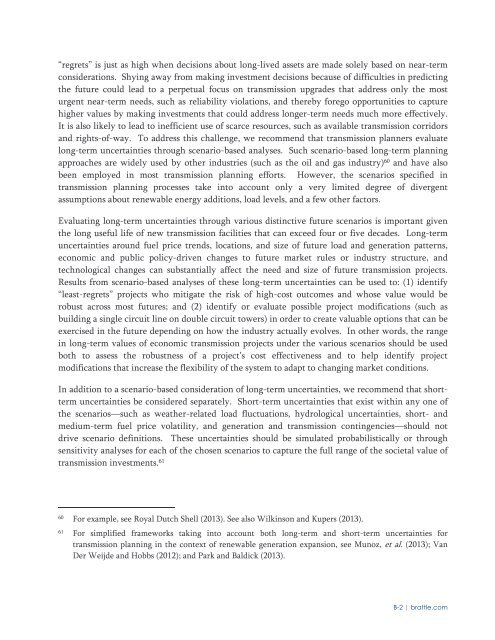THE BRATTLE GROUP
pvrbYG
pvrbYG
Create successful ePaper yourself
Turn your PDF publications into a flip-book with our unique Google optimized e-Paper software.
“regrets” is just as high when decisions about long-lived assets are made solely based on near-term<br />
considerations. Shying away from making investment decisions because of difficulties in predicting<br />
the future could lead to a perpetual focus on transmission upgrades that address only the most<br />
urgent near-term needs, such as reliability violations, and thereby forego opportunities to capture<br />
higher values by making investments that could address longer-term needs much more effectively.<br />
It is also likely to lead to inefficient use of scarce resources, such as available transmission corridors<br />
and rights-of-way. To address this challenge, we recommend that transmission planners evaluate<br />
long-term uncertainties through scenario-based analyses. Such scenario-based long-term planning<br />
approaches are widely used by other industries (such as the oil and gas industry) 60 and have also<br />
been employed in most transmission planning efforts. However, the scenarios specified in<br />
transmission planning processes take into account only a very limited degree of divergent<br />
assumptions about renewable energy additions, load levels, and a few other factors.<br />
Evaluating long-term uncertainties through various distinctive future scenarios is important given<br />
the long useful life of new transmission facilities that can exceed four or five decades. Long-term<br />
uncertainties around fuel price trends, locations, and size of future load and generation patterns,<br />
economic and public policy-driven changes to future market rules or industry structure, and<br />
technological changes can substantially affect the need and size of future transmission projects.<br />
Results from scenario-based analyses of these long-term uncertainties can be used to: (1) identify<br />
“least-regrets” projects who mitigate the risk of high-cost outcomes and whose value would be<br />
robust across most futures; and (2) identify or evaluate possible project modifications (such as<br />
building a single circuit line on double circuit towers) in order to create valuable options that can be<br />
exercised in the future depending on how the industry actually evolves. In other words, the range<br />
in long-term values of economic transmission projects under the various scenarios should be used<br />
both to assess the robustness of a project’s cost effectiveness and to help identify project<br />
modifications that increase the flexibility of the system to adapt to changing market conditions.<br />
In addition to a scenario-based consideration of long-term uncertainties, we recommend that shortterm<br />
uncertainties be considered separately. Short-term uncertainties that exist within any one of<br />
the scenarios—such as weather-related load fluctuations, hydrological uncertainties, short- and<br />
medium-term fuel price volatility, and generation and transmission contingencies—should not<br />
drive scenario definitions. These uncertainties should be simulated probabilistically or through<br />
sensitivity analyses for each of the chosen scenarios to capture the full range of the societal value of<br />
transmission investments. 61<br />
60<br />
For example, see Royal Dutch Shell (2013). See also Wilkinson and Kupers (2013).<br />
61<br />
For simplified frameworks taking into account both long-term and short-term uncertainties for<br />
transmission planning in the context of renewable generation expansion, see Munoz, et al. (2013); Van<br />
Der Weijde and Hobbs (2012); and Park and Baldick (2013).<br />
B-2 | brattle.com


